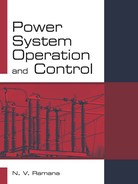2.4 SOLUTION OF THE ECONOMIC SCHEDULING PROBLEM – CONSIDERING TRANSMISSION LINE LOSSES
For optimal power dispatch, the incremental fuel cost of each plant multiplied by its penalty factor should be equal to Lagrangian multiplier λ.
where  = pentaly factor of ith unit.
= pentaly factor of ith unit.
The incremental transmission loss ![]() can be obtained by differentiating the total loss equation PL. The equation for PL interms of B-coefficients has been developed earlier.
can be obtained by differentiating the total loss equation PL. The equation for PL interms of B-coefficients has been developed earlier.
Recall the incremental cost of the ith unit.
The incremental transmission loss(ITL) of the ith unit is:
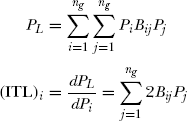
Substituting in the co-ordinate equation
or

Separating the ith term,

from the above, Pi is,
or

2.4.1 Algorithm
The algorithm for economic scheduling of plant load amongst ng generating units involves the following steps:
- Read generator characteristics i.e., βi and ri for i = 1, 2, …, ng.
- Read total plant load PD and B-coefficients.
- Choose initial value of λ = λ0.
- Set all Pi = 0, for i = 1, 2, …, ng.
- Set iteration count r = 1
- Solve Pi(r) from Eq.(2.24)

for i = 1, 2, 3 …, ng units
- Using Pi values, compute PL from

- Check if equality constraint

(specified error) is satisfied or not.
If YES, stop iteration process, print results. If NO, Goto Step-9.
- If error value in step-8 is negative then increase λ and Δλ (a suitable increment) or, decrease λ by Δλ if error is positvie.
- Repeat the iteration processly set r = r + 1; Goto Step-5.
Note: If inequality constraint
Pimin ≤ Pir ≤ Pimax is not satisfied at the end of Step-6, then we set Pi = Pimax or Pimin to constant and scheduling is done only for the rest of the generating units.
The iterative procedure is illustrated with the following numerical examples.
Example 2.5
The incremental cost of production of two generating units are given as:

The B-coefficients in MW-1 are given by
For a given cost of received power λ=2.5 Rs/MWh, compute economic power generation by the units, total losses in the system and total plant load.
Solution:

From the above,
Using Eq.(2.23),

Substituting numerical values

Again using Eq. (2.24)
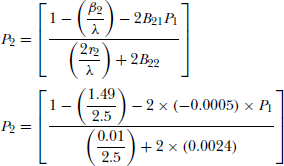
or
set P1(0) = P2(0) = 0 MW
Using (1)
Using (2)
Second iteration:

Third iteration:
Continuing the iteration process,
With accuracy up to the 4th decimal, the optimal scheduling for λ = 2.5 Rs/MWh is:
Total loss at this generation is
PL = (0.0014 × 36.77762 + 2 × (−0.0005) × 36.7776 × 50.0883 + 0.0024 × 50.08832)
= 1.8936 − 1.8421 + 6.0212
= 6.0727MW
Total load demand at this scheduling is:
or
With loss coefficients and incremental production costs given in Example 2.5, allocate a total load of 80.7931 MW between the two units optimally and also determine the incremental cost of received power in Rs/MWh.
Solution:
Let λ° = 2.6;† P1° = P2° = 0MW.
First iteration:
Using Eq.(2.24)
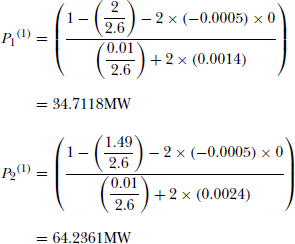
Transmission loss for the above generation is:
PL = 0.0014 × 34.71182 × 2 × (−0.0005) × 34.7118 × 64.2361 + 0.0024 × 64.23612
= 9.3601MW
Check equality constraint.

Since ∑ Pi – PL – PD > 0, λ value must decrease.
Second iteration:
Let λ(1) = 2.4
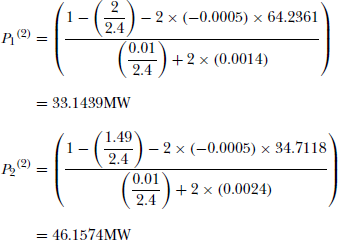
P2 = 0.0014 × 33.14392 + 2 × (−0.0005) × 33.1439 × 46.1574 + 0.0024 × 46.15742
= 5.1213MW
Check equality constraint.

Since ∑ Pi – PL – PD < 0, λ value should increase.
Third iteration:
Let λ(2) = 2.5
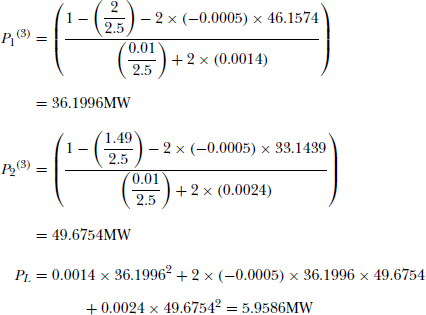
Since the error is small, λ can be fixed at 2.5Rs/MWh.
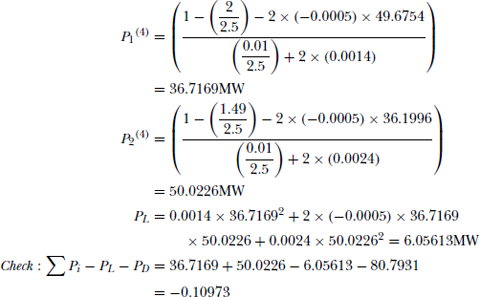
Next iteration:

Final result:
P1 = 36.768MW; P2 = 50.08146MW
P2 = 6.0708MW; Cost of received power = 2.5Rs/MWh
Example 2.7
The incremental fuel cost of two plants are:
The loss coefficients are given in the following matrix:
For the value of incremental cost of received power λ =Rs 25/MWh, find the economically scheduled generation of both plants, total load and losses.
Solution:
The total loss formula in B-coefficients is:
Differentiating PL with respect to P1 and P2 gives the ITL of the two units

For optional scheduling,
where
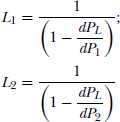
From (3),
and
From (4)
Simplifying the above,
From (5),
Simplifying the above,
Now the transmission loss at this generation is
P2 = 0.002 × 502 − 0.0008 × 50 × 75 + 0.0024 × 752
= 15.5MW
The total plant load is:
Example 2.8
Consider a 2-Bus, two generator power system shown in the Fig. 2.6.

Fig 2.6
When 110MW power is transmitted from Bus-1 to load at Bus-2, a transmission loss of 10MW is incurred. The incremental fuel costs of G1 and G2 are:
Find the power received by the load and the optimal generation by G1 and G2 when the incremental cost of received power of the system is Rs 20/MWh
Solution:
As the total load is placed at Bus-2, B22 = B12 = B21 = 0 (refer Example. 2.4)
The loss equation is:
For P1 = 110MW; P2 = 10MW (given).
Therefore,
For optimal scheduling,
or
where,

Substituting λ = 20,
From the above,
and
For optimal scheduling,

Therefore,
From the above,
Thus,
Therefore, PD = Total load = ∑ P1 – P2 =174.105 MW
The incremental cost of generation of two generating units are given as:
The optimal allocation of total plant load yields the generation of two units as P1 = P2 = 100MW. If the penalty factor of Unit-1 is 1.2, find the penalty factor of Unit-2
Solution:
Incremental cost of generation (IC) of two units at
P1 = P2 = 100MW is:
Considering losses, at optimal allocation the coordinate equation is:
i.e 40 × 1.2 = 30 × L2
Therefore, L2 = 1.6 (Penalty factor of Unit-2)
